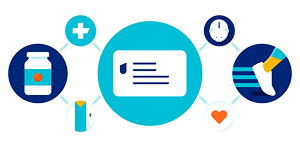Depression is a complicated mental health condition that affects every person differently. But in order to treat it, medical experts have to start with some generalizations.
For starters, depression is when you have a sense of sadness, emptiness or despair that lasts for weeks or longer. While feelings of sadness might come and go in everyday life, depression hangs over you all the time.
Beyond that, there is a lot of variation from one person to another. And that can be different based on your sex.
Women are about 40% more likely to have a depressive episode. And when they do, the symptoms often look different than they do for men.
“Men are more likely to experience irritability and anger, while women are more likely to experience hopelessness, worthlessness and guilt,” says Gail Saltz, M.D. She’s a clinical associate professor of psychiatry at the New York-Presbyterian/Weill Cornell Medical College.
That said, both men and women can have any of these symptoms, adds Dr. Saltz, who also hosts the How Can I Help? podcast. But sex is often a predictor.
If you’re experiencing sadness or know someone who is, you might be curious about the signs of depression to look for. As it turns out, the answer may depend on whether you’re talking about a man or a woman.
Our Mind Your HealthTM plan lets you meet with therapists and coaches from the comfort of your own home. Go online to learn more.
Spotting the signs of depression
Recognizing the signs of depression is often the first step toward getting help. That’s why it’s important to know what to look for.
For women, symptoms of depression often show up in ways that are internally focused, says Kim Homan. She’s a licensed marriage and family therapist and the clinical director of Tennessee Behavioral Health in Murfreesboro, Tennessee.
Because depression occurs more frequently in women, the symptoms that are most often linked to the disorder are female focused.
But depression in men may look different. Men are more likely to lash out. They may do so with anger or substance abuse.
Men may find it more difficult to talk about feelings of sadness or worthlessness, making them less likely to reach out for help. And the condition can be severe. Men are nearly 4 times more likely to die by suicide.
If you or anyone you know is worried about self-harm, it’s important to get help. You can contact the Suicide and Crisis Hotline by dialing 988.
What are the symptoms of depression in women vs. men?
It’s worth repeating that every person with depression experiences the condition differently. That said, here’s an overview of how sex may affect depression:
- Women are more likely to feel sad, worthless and guilty. They may find that it seems impossible to cope with daily tasks and responsibilities.
- Men are more likely to be irritable or aggressive. “These emotions can sometimes be mistaken for anger issues rather than depression,” says Homan.
- Women are more likely to have changes in appetite. This can lead to “either weight gain or loss that’s not intentionally planned,” says Homan.
- Men are more likely to have headaches, a racing heart or chronic pain. They may seek help for these issues instead of for depression.
- Women are more likely to sleep too much or too little. “It’s not unusual for women to have a pronounced decrease in energy, feeling tired all the time no matter how much they rest,” says Homan.
- Men are more likely to engage in risky behaviors. These may include reckless driving, substance abuse or unsafe sex. They may also throw themselves into work. “It’s a way to try to escape feelings,” says Homan.
To complicate this, women are more likely to have depression tied to hormonal changes. This can occur around the menstrual cycle or in the lead-up to menopause. It may also occur during pregnancy (“prenatal” depression) or after childbirth (“postpartum” depression).
Finding mental health help is much easier with our virtual membership, which allows you to get care from your own home and at a convenient time for you. Learn more about the plan’s benefits now.
How to manage symptoms of depression
While symptoms of depression may differ based on sex, the treatment is often the same whether you’re male or female. Here are some options:
- Ask for help. Some people may find it easiest to talk to a trusted friend. That’s a great place to start.
- Seek out online support groups that allow you to be honest without the fear of being identified.
- Talk to a professional. This could be a primary care provider, therapist or counselor.
A professional will help create a personalized plan for you and get you on the path to healing. They may offer one or more of these treatments:
1. Medication. Your doctor may recommend that you take antidepressants. These are prescription drugs that change how your brain manages chemicals involved with mood.
Antidepressants usually take 4 to 8 weeks to kick in before you start to see an improvement. You may need to try several different medications before you find the one that works for you.
If you begin to take an antidepressant, don’t stop taking it on your own. Sometimes, people stop these medications once they begin to feel better. But if you do that, the symptoms may come back.
Most people need to be on these drugs for at least 9 to 12 months. After that, you can talk to your doctor about whether you can lower your dose.
2. Talk therapy. Along with medication, your doctor may recommend counseling. If so, your doctor may refer you to a psychologist or psychiatrist. A psychologist usually has a Ph.D. and may be able to prescribe medication in some states. A psychiatrist is a medical doctor who can prescribe medications.
Therapy can be tailored to your needs. It can focus on identifying and changing harmful thought patterns, coping with stress or improving social connections.
The focus may also change depending on whether you are male or female. “Therapy for men might focus more on managing anger and risky behaviors, while for women it might center on addressing feelings of guilt and self-worth,” says Homan.
3. Lifestyle changes. There are also things you can do on your own to help yourself feel better. These include:
- Exercise daily. Experts have long known that boosting heart rate can boost mood. And a recent large review of studies from the British Journal of Sports Medicine confirmed it. It found that exercise was even more effective than medication or talk therapy.
- Keep scheduled sleep times. Going to bed and waking up at the same time every day keeps you in a routine and ensures that you get enough rest. That’s important for a healthy mood.
- Eat healthy, minimally processed foods. A study from Harvard Medical School found that people with the most processed foods in their diet were significantly more likely to have depression.
- Stay connected with others. Social support can help buffer some of the effects of depression. It helps to talk with people you trust about your feelings.
- Avoid alcohol or recreational drugs. They may temporarily make you feel better, but they can have a negative effect over the long term.
Depression can be life changing. But once you can spot the signs, you’ll be on the way to getting the treatment you need.
Enter your zip code to find the virtual care plan options available in your area or contact a licensed insurance agent at 1-844-211-7730 for more information.
For informational purposes only. This information is compiled by UnitedHealthOne and does not diagnose problems or recommend specific treatment. Services and medical technologies referenced herein may not be covered under your plan. Please consult directly with your primary care physician if you need medical advice.
Sources:
Brain Imaging and Behavior. “Brain-based sex differences in depression: a systematic review of neuroimaging studies.” April 14, 2023. Retrieved from https://www.ncbi.nlm.nih.gov/pmc/articles/PMC10102695/
British Journal of Sports Medicine. “Effectiveness of physical activity interventions for improving depression, anxiety and distress: an overview of systematic reviews.” September 2023. Retrieved from https://pubmed.ncbi.nlm.nih.gov/36796860/
Columbia University. “Depression.” December 22, 2022. Retrieved from https://www.health.columbia.edu/content/depression
Harvard Health Publishing. “Depression.” Retrieved from https://www.health.harvard.edu/topics/depression Accessed February 20, 2024
JAMA Network Open. “Consumption of ultraprocessed food and risk of depression.” September 20, 2023. Retrieved from https://www.ncbi.nlm.nih.gov/pmc/articles/PMC10512104/
National Institute of Mental Health. “Depression.” September 2023. Retrieved from https://www.nimh.nih.gov/health/topics/depression
National Institute of Mental Health “Major depression.” July 2023. Retrieved from https://www.nimh.nih.gov/health/statistics/major-depression
National Institute of Mental Health. “Psychotherapies.” February 2024. Retrieved from https://www.nimh.nih.gov/health/topics/psychotherapies
University of Utah. “Men may not recognize or downplay signs of depression.” June 26, 2023. Retrieved from https://healthcare.utah.edu/healthfeed/2023/06/men-may-not-recognize-or-downplay-signs-of-depression
Vital Statistics Rapid Release. “Provisional estimates of suicide by demographic characteristics: United States, 2022.” November 2023. Retrieved from https://www.cdc.gov/nchs/data/vsrr/vsrr034.pdf
Compliance code:
50647-X-0401










